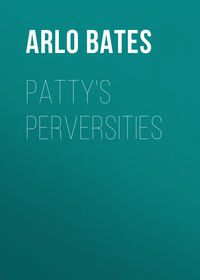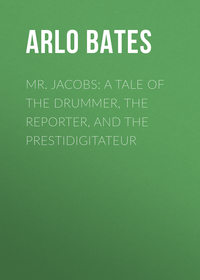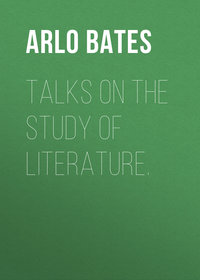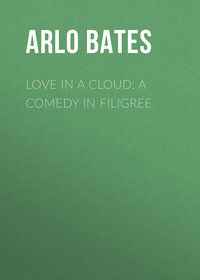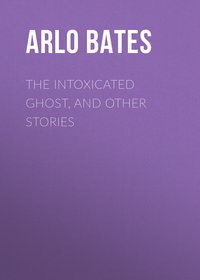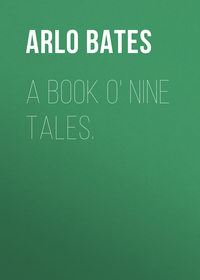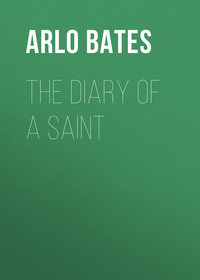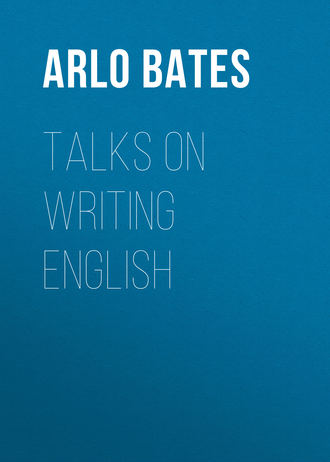 полная версия
полная версияTalks on Writing English
Coleridge, on the other hand, suggests a picture rather than gives one directly: —
Hast thou a charm to stay the morning starIn his steep course? So long he seems to pauseOn thy bald, awful head, O sovran Blanc!In the one case there is a statement of particulars, and from these separate features the reader is expected to build up the scene before his mental vision. In the other there is merely a suggestion of the morning star hovering lingeringly over the snowy, awe-inspiring crest of the mighty mountain. It seems to me that in this especial instance Coleridge, for once at least, has the better of Shelley, and that the implied picture is more vivid and effective than the picture more carefully elaborated.
To take an illustration from prose, let us contrast the description which Dickens gives of Sairey Gamp with that of Mrs. Fezziwig. Of the former he says: —
She was a fat old woman, this Mrs. Gamp, with a husky voice and a moist eye, which she had a remarkable power of turning up and only showing the white of it.6 Having very little neck, it cost her some trouble to look over herself, if one may say so, at those to whom she talked. She wore a very rusty gown, rather the worse for snuff, and a shawl and bonnet to correspond… The face of Mrs. Gamp – the nose in particular – was red and swollen; and it was difficult to enjoy her society without becoming conscious of a smell of spirits.
Of the other lady Dickens merely remarks: —
In came Mrs. Fezziwig, one vast substantial smile.
Good as the former of these descriptions is of its kind, it seems to me that if this were all that we were told about these two characters, we should have in the mind a more distinct picture of Mrs. Fezziwig than of Mrs. Gamp. One is not obliged to share this opinion, however, to appreciate the difference between the two methods.
In Direct Description, the first thing to be considered, after the point of view is selected, is what is the central idea of the picture which is to be produced. It is apt to be the fact that from a description the reader gets one clear and vivid impression to which all else is subordinate, and beside which all else is comparatively vague. It is therefore often wise to put all the real stress upon the points to be accented, leaving the reader to imagine the rest.
The matter of selecting the central thought is of the more weight, since it is important that this be given clearly to the reader at its first presentation. Whoever has tried to alter a mental image knows how difficult it is to change a picture which is already defined in the imagination. If the mind in constructing a picture has conceived of a mountain as standing on the right, and afterward finds that the author intended it to be on the left, it is on the right that that mountain is likely to remain in the ideal landscape. I have always been a little troubled by the fact that in his description at the commencement of “The Merry Men,” Stevenson, careful and exquisite artist though he was, speaks of the “great granite rocks that … go down together in troops into the sea, like cattle on a summer’s day;” and then, a little later, declares that “on calm days you can go wandering between them in a boat for hours, echoes following you about the labyrinth.” From the comparison to cattle, I always get the idea of boulders much smaller than the second sentence shows to have been intended. The readjustment is an unpleasant break which jars upon the reality of the whole.
In the first example which I gave you, we are told that the writer saw a glade, covered with soft, thin grass, speckled with flowers. It is added that the glade was set round with trees, and then that on one side were a couple of tall boulders, across which had fallen a large beech tree. This does not seem the natural or the effective order. The eye would first notice that the glade was set about with trees, next that there was the large fallen tree, lying across the boulders, and only after this see that the ground was covered with flower-spotted, thin grass.
Here is another example which illustrates the same error: —
Vervain saw before him a rude mob, armed with all sorts of improvised weapons. They had evidently caught up scythes, bill-hooks, axes, or whatever came first to hand. In the midst of them his eye distinguished Henley and Western, and they were all led by a large, coarse man with a red cap, who seemed to have some authority over them. They were marshaled into a rude order, the lines being wavering and uneven, and all were evidently fiercely excited.
The author speaks first of a “rude mob,” a phrase which calls up a formless and confused mass of men. We are next told that in the midst the spectator recognized two acquaintances, then that there was a leader, and after that that the crowd was moving in rude order, with uneven lines. This last statement forces the reader to alter, if he can, his first impression, and instead of imagining a confused crowd, to think of a company irregularly organized. If the writer had really seen in his own mind the thing of which he wrote, he would in the first place have spoken of the mob as a company led by a leader conspicuous in his red cap, and marching in wavering lines. After this he would have been conscious of the rough and improvised weapons, and only after all these things had forced themselves upon his attention would there have been any recognition of individuals.
To select the central idea it is generally safe to consider what one’s own first or strongest impression was or would be at sight of the thing pictured. The effective order is usually that which would be the actual experience of the reader if he were standing in the flesh at the point of view indicated by the author. This is the natural method, and while it has its dangers, it is at once practical and logical. In any case, there must be some reason for the order, so that the reader may be led from one point to the next. Consecutiveness is the logic of Description and Narration.
As an example of describing where the details are arranged as they would be likely to catch the attention of the spectator, we may take this picture from that classic of American literature, Sylvester Judd’s “Margaret:” —
The pond covered several hundreds of acres, its greatest diameter measuring about a mile and a half; its outline was irregular, here divided by sharp rocks, there retreating into shaded coves; and on its face appeared three or four small islands, bearing trees and low bushes. Its banks, if not really steep, had a bluff and precipitous aspect from the tall forest that girdled it about. – Ch. i.
Or this exquisite bit from Stevenson: —
The river there is dammed back for the service of the flour-mill just below, so that it lies deep and darkling, and the sand slopes into brown obscurity with a glint of gold; and it has but newly been recruited by the borrowings of the snuff-mill just above, and these, tumbling merrily in, shake the pool to its black heart, fill it with drowsy eddies, and set the curded froth of many other mills solemnly steering to and fro upon the surface. —The Manse.
Dickens observes this natural order in many of his detailed pictures of persons. The portrait of Mr. Grimwig may serve as an example: —
At this moment there walked into the room, supporting himself by a thick stick, a stout old gentleman, rather lame in one leg, who was dressed in a blue coat, striped waistcoat, nankeen breeches and gaiters, and a broad-brimmed white hat with the sides turned up with green. A very small-plaited shirt-frill stuck out from his waistcoat, and a very long steel watch-chain, with nothing but a key at the end, dangled loosely below it. The ends of his white neckerchief were twisted into a ball about the size of an orange; the variety of shapes into which his countenance was twisted defy description. He had a manner of screwing his head round on one side when he spoke, and looking out of the corners of his eyes at the same time, which irresistibly reminded the beholder of a parrot. —Oliver Twist.
This elaboration of particulars is somewhat out of fashion. Particulars are grasped by the eye so quickly that the deliberation of words is apt to destroy proportion, while it is also true that the reader is in danger of forgetting the beginning before he reaches the end.
It is perhaps worth while to give an example of the abuse of this method, since all inexperienced writers have a tendency to mistake a catalogue for a description. It is manifestly idle to pile up particulars, unless they are kept subordinate to some central thought. Here is the description of the heroine of a modern English novel, “A Chelsea Householder:” —
To begin, then, Muriel was tall, with a slight, erect figure, a quick step, and an air of youth and vigor which did the beholder good to look at.7 Her face was oval, as nearly oval at least as a face can be in which the chin is a good deal more pronounced than is usual in classic beauties. The cheeks were pale, paler than they had any business to be, judging by the rest of the physique, the most noticeable fact in point of coloring being that the eyes, hair, brows, and lashes were all of the same, or pretty nearly the same, color – a deep, dark brown, inclining to chestnut above the temples, from which the hair was brushed courageously back, so as to form a small knot at the back of the head. Her eyes – not, perhaps, by the way, a strikingly original trait in a heroine – were large and bright; indeed, brighter or pleasanter eyes have seldom looked out of a woman’s face, their beauty consisting less in their size and color than in this very vividness and brightness, which seemed to shine out of the irises themselves. For all that, the face in repose was not exactly a bright one, or rather the brightness came to it only by fits and starts, its prevailing expression being a somewhat sober one, a sobriety giving way, however, at a touch, and being replaced by a peculiarly sunshiny smile and glance.
This is not the whole of the paragraph, but it is enough for our purpose. There need not be a better example of how not to do it, or of how much may be said about a thing without conveying any definite idea of it. For my own part, I have no idea whatever how Muriel looked, and long before I got half through her verbal portrait I had ceased to care. Few faults are more common than this furnishing a list of particulars in the expectation that the reader will construct therefrom the picture which the author has not been clever enough to make clear – a method, it might be added, not unlike the system of punctuation adopted by the late so-called Lord Timothy Dexter, who put all the points together at the end of his book, and directed his readers to distribute them at their own pleasure.
It is hardly needful to remark upon the prime necessity of clearness in description, but it is perhaps not amiss to remind beginners that it is not possible to picture a thing which the writer does not himself see. If he is writing of an imaginary landscape and speak of a tree, he should be able if he choose to count the branches of that tree as clearly as if it in reality stood before him. Unless he know whether the heads of the flowers tip to the right or to the left, whether the sheep on the hillside of which he writes are nearer the fence on the one side or to the stone wall on the other, unless he can with inner vision actually see the shape of the heroine’s head and the length of her fingers, the slope of her neck and the folds of her gown as if she were in bodily presence before him, he cannot describe any of these things. He cannot tell what he does not know. More than that, he cannot tell to others as much as he knows; so that unless he be able to see a good deal more than he wishes to impart, he will fail to convey as much as he desires.
It is of importance to cultivate the habit of visualizing things, if one intends to describe them. The mind should be trained to conceive of them as visibly before it. This is the only way of arriving at the power of vivid portrayal. It is easy to go through the books of great writers and select those which show that the authors have this power of visualization. If a writer has it not, no skill of diction or of construction can avail to supply its lack.
In Description we have again occasion to emphasize the rule which was given in Exposition: proceed from the near to the remote; from the physical to the mental; from the obvious to the obscure. Homer, surpassed in happiness of epithet by Shakespeare only, affords abundant illustrations of this point. He says, for instance: “Wheels round, brazen, eight-spoked;” “shields smooth, beautiful, brazen, well-hammered.” The particulars are given in the order in which they would naturally be observed. That the wheel is round and that the shield is smooth, the eye perceives at once. The second glance adds the fact of material, and so on.
What is meant by taking up the physical before the mental is illustrated by the following sentence from a theme picturing the appearance of a harbor in the West Indies: —
In the distance I saw six or seven vessels in quarantine for yellow fever, all flying yellow flags.
The process of the mind is here reversed. The spectator sees the flags and reflects that they indicate quarantine for yellow fever. It is not, as a general thing, well to intersperse these mental comments. It may properly be done in a case like this, because in reading, as in seeing, the mind is likely to inquire what is the signification of the yellow flags; and it is well to answer this question in order that the reader’s attention do not wander in search of an answer. If this is to be done, however, the physical appearance which gives rise to the interrogation should be given first. To reverse the order is something like giving first an answer and then the conundrum to which it belongs.
It is as bad as mixing metaphors to mingle physical and mental characteristics. In a description of the volcano of Kilauea I found this sentence: —
The combination of vivid red and green contrasted with the deathlike quiet and grandeur of the crater.
It is not possible to contrast physical qualities like color with emotional ones such as quiet and grandeur. It is like multiplying pictures by potatoes.
Of effects used in Description the appeal to the sight is manifestly by far the most effective. Indeed, it is to be questioned whether any other is of use save in very rare instances. Of course the individual temperament of the reader has much to do with this matter, and I am perhaps influenced by the fact that while it is very easy for me to see things in imagination it is rather difficult for me to hear them. There is no question, however, that an appeal to the sense of hearing is with the average reader less likely to be convincing than that to sight. It seems to me also that the use of smell is less often successful than either of the others, and yet Kipling has shown how effective this may be if employed by a master. The mention of odors is more likely, perhaps, to belong to description by suggestion than to description simple and direct.
An important element in Description is movement. This consists in showing the details of a picture as if the mind of the reader were moving from one to another. It is secured by naming them as they would be observed; by presenting them as they would successively become apparent to some other person; or by exhibiting them in connection with their effects. Perhaps I may be able to show this by three brief pictures of a peasant girl.
1. She was a beautiful peasant girl, tall and slender, dressed in the fashion of the country, and carrying in her hand a bunch of scarlet poppies. Her snowy coif was pushed back, showing brown cheeks, a mass of black hair, and bright, startled eyes.
2. Paul watched the tall, slender peasant come up the flowery lane, twirling in her hand as she walked a handful of flaming red poppies. He was sure that she had not noticed him, and he smiled at the unconscious beauty of her brown face, clear eyes, and black, wavy hair.
3. The artist’s gaze was suddenly arrested by a tall peasant girl, who walked slowly up the lane. He stopped to watch her, attracted by the grace of her slender figure, and noting appreciatively the effect against her gray gown of the scarlet poppies which she was twirling in her brown hands. As she drew nearer, and unconsciously pushed back the snowy coif, an involuntary exclamation escaped his lips at the brilliancy of the eyes which flashed out at him from beneath her black, tumbled hair.
Such movement as there is in the first of these depends upon the arrangement of the particulars in the order in which they would naturally be perceived by the reader; in the second this order is shown to be natural by presentation of the details as if they were seen by a spectator; while in the third the effect is heightened by the introduction of the emotions aroused in the mind of the artist by the sight of the girl. Whether these examples make the fact clear or not, there is no question that the last form is the most effective. It is not always available, nor is it always appropriate; but when it is possible it is more vivid and persuasive than any other method. There is in it more suggestiveness, and hence there is more force.
As a practical example of the use of this method, this from Thomas Hardy may serve: —
How very lovable her face was to him! There was nothing ethereal about it; all was real vitality, real warmth, real incarnation. Yet when all was thought and felt that could be thought and felt about her features in general, it was her mouth which turned out to be the magnetic pole thereof. Eyes almost as deep and speaking he had seen before, and cheeks perhaps as fair; brows as arched, a chin and throat almost as shapely; her mouth he had seen nothing at all to equal on the face of the earth. To a young man with the least fire in him, that little upward lift in the middle of her top lip was distracting, infatuating, maddening. He had never before seen a woman’s lips and teeth which forced upon his mind, with such persistent iteration, the old Elizabethan simile of roses filled with snow. —Tess of the D’Urbervilles, xxiv.
XV
DESCRIPTION CONTINUED
Description by Suggestion is perhaps not to be called Description in the exact meaning of the word, but in so far as it is an attempt to call up an image it is proper to consider it so. Even if it seem but an attempt to induce in the mind the spirit of a scene, a character, or a thing, it may still be treated as Description, since the main purpose is to bring vividly to the thought of the reader the image of the thing spoken of.
It has already been said that words can add no material image to those in the mind, but must work by the rearrangement of what is already there. If I read the account of a little rustic pond I call to mind some sheet of water that I have seen. If I have lived in the South the picture is likely to be that of a lakelet bordered by moss-hung trees, while if my experiences have been confined to New England I shall involuntarily think of northern foliage and scenery. I shall in any case construct out of old images this new one. Now the mind is best able to do this for itself if simply properly aroused and guided instead of being too minutely directed. In direct description the author adds particular to particular, bidding the reader put one detail in place by the others. If a writer do this with sufficient skill, he may succeed in inducing the consciousness of the reader to follow him; but always he is leading and the other is being led. On the other hand, when a suggestion is used the reader is aroused to take, as it were, the initiative. When Dickens calls Mrs. Fezziwig “one vast, substantial smile,” he stimulates the reader to picture the woman for himself. Here the imagination of the one who reads takes the lead instead of following. It goes by the path pointed out by the author, but it goes by itself. The result is that freshness and clearness of impression which belong only to what the mind does or seems to do voluntarily.
This is perhaps making more of a show of psychology than the occasion calls for or than my knowledge of that difficult science warrants; but at least it may serve to emphasize once more the fact that whatever the writer can induce the reader to do for himself is sure to be greatly more effective than anything which the writer can do for him. Herein lies the value of suggestive description. It arouses the mind to be actively receptive. Another way of putting the same thing would perhaps be to say that avowed description appeals more to the understanding, while suggestion addresses itself more directly to the imagination.
The simplest form of any description is of course the epithet. This in literal description is apt to be ineffective from its meagreness. In suggestion it is often rich and satisfactory. When Homer speaks of the “swift-footed Achilles,” he has not pictured the hero, yet he conveys by the implication of the epithet an image which is not without distinctness. The same is true of such Homeric phrases as “far-darting Apollo,” “laughter-loving Aphrodite,” or “ox-eyed Juno.” In the same way into a single simile may be condensed a description by suggestion which could be given directly only by pages. To go to the “Iliad,” again, take this example: —
As the gusts speed on, when shrill winds blow, on a day when dust lies thickest on the roads, and the winds raise together a great cloud of dust, even so their battle clashed together, and all were fain of heart to slay each other in the press with the keen bronze. – Lang’s Iliad, xiii.
There is here no direct picture, yet the mind sees the confused and furious onslaught more clearly than if all its details were enumerated.
Lowell notes a happy instance of this sort of picturing by intimation when he says of Chaucer:
Sometimes he describes amply by the merest hint, as where the Friar, before setting himself down, drives away the cat. We know without need of more words that he has chosen the snuggest corner.
Another remark which Lowell makes in this connection I cannot pass without quoting: —
When Chaucer describes anything, it is commonly in one of those simple and obvious epithets or qualities that are so easy to miss. Is it a woman? He tells us that she is fresh; that she has glad eyes; that “every day her beauty newed.”
Notice the phrase, “those simple and obvious epithets or qualities that are so easy to miss.” Whatever we may learn later, we all begin by supposing that it is imperative for a writer to go far afield, and to discover traits, epithets, and thoughts that nobody has used before. Here as in all writing he succeeds best who most carefully confines himself to just those traits, epithets, and thoughts which people have used before, but who so uses them that they have new force. He must feel so keenly whatever he writes that his words shall seem new because of the conviction behind them; and the reader will find a continual charm in this discovery, as it were, of the meaning of familiar terms.
In common practice it is seldom that either of the two sorts of composition which I have named is used alone, and the most successful method is that which happily unites them. No literature can go far or effect much which does not call suggestion to its aid, and this is perhaps more emphatically true in Description than in any other division of composition. Description is really a kind of continued comparison of the image which is in the mind of the writer with things which the reader may be supposed to have seen. As in the use of comparison in simile, suggestion is the most effective tool at the hand of the craftsman. It might be added that the rules given for the use of figures will be found, by one who takes the trouble to examine them, to be practically and directly applicable to Description.
I have spoken carefully thus far as if Description had to do with nothing save the picturing of the physical. There was perhaps danger lest the word “picture” might seem forced if too soon applied to things mental and intangible. Description, however, has as one of its common and legitimate functions, perhaps as its highest office, the picturing of conditions of mind, of states of emotion, of all sorts of mental experiences. Its office is to call them up so vividly that the reader shall realize and share them. Not that he shall feel them as his own, but as if he saw them with the most intimate and sympathetic comprehension of them. If the reader received the sorrow of King Lear as his own, he would be in danger of going mad as King Lear went mad. If he shared as a personal experience the love of Romeo for Juliet, no other maid of actual flesh and blood would satisfy his devotion. It is not as a personal but as an imaginative experience that one is to enter into these passions. The description of an emotion is an endeavor to give a picture of it in much the same sense that a picture of a landscape is given. The reader does not in either case mistake the mental impression for the actual thing, but in both instances he is moved by the completeness and reality of the portrayal.


